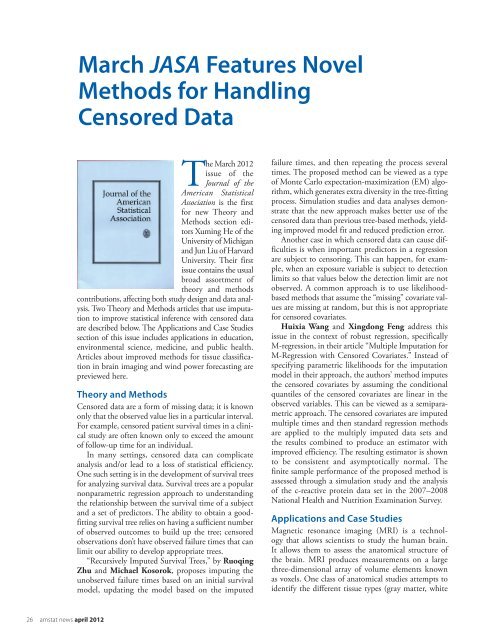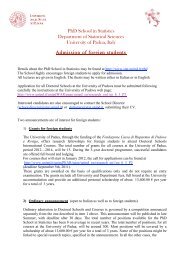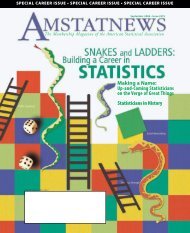Amstat News - American Statistical Association
Amstat News - American Statistical Association
Amstat News - American Statistical Association
You also want an ePaper? Increase the reach of your titles
YUMPU automatically turns print PDFs into web optimized ePapers that Google loves.
26 amstat news april 2012<br />
March JASA Features Novel<br />
Methods for Handling<br />
Censored Data<br />
The March 2012<br />
issue of the<br />
Journal of the<br />
<strong>American</strong> <strong>Statistical</strong><br />
<strong>Association</strong> is the first<br />
for new Theory and<br />
Methods section editors<br />
Xuming He of the<br />
University of Michigan<br />
and Jun Liu of Harvard<br />
University. Their first<br />
issue contains the usual<br />
broad assortment of<br />
theory and methods<br />
contributions, affecting both study design and data analysis.<br />
Two Theory and Methods articles that use imputation<br />
to improve statistical inference with censored data<br />
are described below. The Applications and Case Studies<br />
section of this issue includes applications in education,<br />
environmental science, medicine, and public health.<br />
Articles about improved methods for tissue classification<br />
in brain imaging and wind power forecasting are<br />
previewed here.<br />
Theory and Methods<br />
Censored data are a form of missing data; it is known<br />
only that the observed value lies in a particular interval.<br />
For example, censored patient survival times in a clinical<br />
study are often known only to exceed the amount<br />
of follow-up time for an individual.<br />
In many settings, censored data can complicate<br />
analysis and/or lead to a loss of statistical efficiency.<br />
One such setting is in the development of survival trees<br />
for analyzing survival data. Survival trees are a popular<br />
nonparametric regression approach to understanding<br />
the relationship between the survival time of a subject<br />
and a set of predictors. The ability to obtain a goodfitting<br />
survival tree relies on having a sufficient number<br />
of observed outcomes to build up the tree; censored<br />
observations don’t have observed failure times that can<br />
limit our ability to develop appropriate trees.<br />
“Recursively Imputed Survival Trees,” by Ruoqing<br />
Zhu and Michael Kosorok, proposes imputing the<br />
unobserved failure times based on an initial survival<br />
model, updating the model based on the imputed<br />
failure times, and then repeating the process several<br />
times. The proposed method can be viewed as a type<br />
of Monte Carlo expectation-maximization (EM) algorithm,<br />
which generates extra diversity in the tree-fitting<br />
process. Simulation studies and data analyses demonstrate<br />
that the new approach makes better use of the<br />
censored data than previous tree-based methods, yielding<br />
improved model fit and reduced prediction error.<br />
Another case in which censored data can cause difficulties<br />
is when important predictors in a regression<br />
are subject to censoring. This can happen, for example,<br />
when an exposure variable is subject to detection<br />
limits so that values below the detection limit are not<br />
observed. A common approach is to use likelihoodbased<br />
methods that assume the “missing” covariate values<br />
are missing at random, but this is not appropriate<br />
for censored covariates.<br />
Huixia Wang and Xingdong Feng address this<br />
issue in the context of robust regression, specifically<br />
M-regression, in their article “Multiple Imputation for<br />
M-Regression with Censored Covariates.” Instead of<br />
specifying parametric likelihoods for the imputation<br />
model in their approach, the authors’ method imputes<br />
the censored covariates by assuming the conditional<br />
quantiles of the censored covariates are linear in the<br />
observed variables. This can be viewed as a semiparametric<br />
approach. The censored covariates are imputed<br />
multiple times and then standard regression methods<br />
are applied to the multiply imputed data sets and<br />
the results combined to produce an estimator with<br />
improved efficiency. The resulting estimator is shown<br />
to be consistent and asymptotically normal. The<br />
finite sample performance of the proposed method is<br />
assessed through a simulation study and the analysis<br />
of the c-reactive protein data set in the 2007–2008<br />
National Health and Nutrition Examination Survey.<br />
Applications and Case Studies<br />
Magnetic resonance imaging (MRI) is a technology<br />
that allows scientists to study the human brain.<br />
It allows them to assess the anatomical structure of<br />
the brain. MRI produces measurements on a large<br />
three-dimensional array of volume elements known<br />
as voxels. One class of anatomical studies attempts to<br />
identify the different tissue types (gray matter, white




